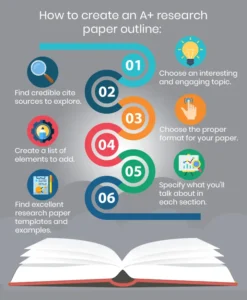Starting a research paper can seem scary, but don’t worry! A research paper outline is like a map that helps you plan your journey. It lists all the things you need to include in your paper, like topics and paragraphs, and even ideas for how to say things.
A Research Paper Outline is a list of all the topics you’ll talk about in your paper, usually organized by paragraphs. It also includes other details like subtopics and where you found your information. Some outlines even have ideas for how to start each sentence.Now that we know what a research paper outline is, let’s learn how to write a research paper outline.
This blog will show you step by step what to do and give you examples, like a research paper outline example, an outline for a research paper, a research paper outline template, a research paper outline format example, and a research paper structure. So, get ready to start planning your paper simply and easily
What is a Research Paper Outline?
A Research Paper outline is a structured plan or framework that serves as a roadmap for organizing and presenting the content of a research paper. It outlines the main topics, subtopics, and supporting details that will be included in the paper, helping to ensure coherence and logical flow.
This structured approach aids in maintaining coherence and logical flow throughout the document, ensuring that the reader can seamlessly navigate through the presented information. By providing a clear overview of the paper’s key components and their respective relationships, the outline serves as an essential tool in the writing process, facilitating effective communication of ideas and enhancing the overall clarity and organization of the research paper. It lays out the direction you’ll take in your writing, helping you stay on track and avoid getting lost in a sea of information. When comparing the outline of a thesis and a research paper, one can identify the Key Difference Between Thesis and Research Paper, which plays a crucial role in guiding the development and structure of each document.
Why Use an Outline?

Why use an outline for a research paper? This is a common question for students starting their academic writing. An outline for a research paper serves as a foundational tool that offers a myriad of benefits throughout the writing process.
- Organization: An outline provides a structured framework for organizing your thoughts and ideas before you begin writing. It helps you arrange your main topics, subtopics, and supporting details in a logical order, ensuring that your paper flows smoothly and coherently.
- Clarity: By outlining your paper, you clarify your ideas and ensure that each point is clearly articulated. This clarity makes it easier for both you and your readers to understand the main arguments and supporting evidence presented in your paper.
- Efficiency: An outline helps you work more efficiently by providing a roadmap for your writing. It allows you to see the big picture of your paper and identify any gaps or areas that need further development before you start drafting.
- Focus: Creating an outline forces you to think critically about your topic and the structure of your paper. It helps you identify the key points you want to make and the evidence you need to support them, keeping you focused on your main arguments throughout the writing process.
- Revision: An outline serves as a valuable tool for revising and refining your paper. It allows you to easily reorganize or rearrange your ideas, add new information, or delete irrelevant content as needed, without having to rewrite large sections of your paper.
Types of Research Paper Outline
Alphanumeric Outline:
- Main Topics: Designated with Roman numerals (I, II, III).
- Subtopics: Designated with capital letters (A, B, C) under each main topic.
- Further Details: Designated with Arabic numerals (1, 2, 3) under each subtopic.
Decimal Outline:
- Main Topics: Labeled with Arabic numerals (1, 2, 3).
- Subtopics: Labeled with decimals (1.1, 1.2, 1.3) under each main topic.
- Further Details: Labeled with sub-decimals (1.1.1, 1.1.2, 1.1.3) under each subtopic.
Full-Sentence Outline:
- Each main and subtopic is written out as a full sentence.
- Provides a detailed overview of each section of the paper.
- Useful when preparing to write the paper.
Topic Outline:
- Main topics are listed without further details or subpoints.
- Provides a condensed overview of the paper’s structure.
- Useful for quickly outlining the main themes or sections of the paper.
Skeleton Outline:
- Includes only essential information such as main headings and key points.
- Provides a bare-bones overview of the outline.
- Useful for quickly jotting down main ideas without going into detail.
Steps of How to Write a Research Paper Outline

Identify the Research Topic and Purpose:
To begin crafting your outline for a research paper, first, define your topic and its purpose. Identify the central question or issue you’re investigating and outline your goals for the research. This clarity in topic and purpose forms the foundation for your outline, guiding its structure and content. It helps align your main points and subtopics with the overarching theme of your paper. By clearly articulating your objectives, you ensure that your outline effectively maps out the direction of your research paper, providing a roadmap for organizing and presenting your ideas coherently and logically. Begin by clearly defining your research topic and the purpose of your paper. What question or problem are you addressing? What do you aim to achieve or explore through your research? Clearly articulating your topic and purpose will guide the direction of your outline.
Organize Your Main Points and Subpoints:
To create a solid research paper structure, begin by identifying the main points you intend to address. These may include key arguments, themes, or sections relevant to your topic. Once you’ve established these main points, further dissect them into subpoints or supporting details. These subpoints should furnish evidence or elaborate on each main point, reinforcing the overall argument or theme of your paper. This hierarchical breakdown ensures a coherent flow of ideas and strengthens the foundation of your research paper structure. It provides clarity for both the writer and the reader, facilitating a more effective communication of your research findings. When considering the organization of your research paper, it’s essential to understand the Do’s and Don’ts of Writing Research Papers, as they can significantly impact the quality and coherence of your final document.
Arrange Points in a Logical Order:
When constructing your research paper outline template, prioritize arranging your main points and subpoints in a logical sequence that bolsters your thesis or research question. Deliberate on the optimal order for presenting your ideas and arguments, whether it’s chronological, thematic, or cause and effect-based, tailored to your research’s nature. This strategic organization enhances the coherence and comprehensibility of your paper, facilitating a seamless progression of thought for your readers. By thoughtfully structuring your outline in this manner, you not only strengthen the framework of your research paper but also enhance its clarity and impact, ensuring a more effective conveyance of your insights and analysis.
Use a Standard Outline Format:
When you’re figuring out “how to write a research paper outline,” it’s important to use a specific format. You can pick a style like alphanumeric or decimal format. This means you’ll label main points with Roman numerals (I, II, III), subpoints with capital letters (A, B, C), and more details with Arabic numerals (1, 2, 3). This way of organizing keeps your outline clear and easy to follow. By following this standard format, you make it simpler for yourself and others to understand your research paper outline and stay on track with your writing.
Review and Revise Your Outline:
After you’ve finished writing your research paper outline format example, it’s important to check it back. Take some time to look it over and make any changes you think are needed. Make sure each main point and subpoint matches what you’re researching and why you’re doing it. Check that everything makes sense and flows well from one part to the next, including your investigation into online assignment help in Canada. If something doesn’t fit or seems out of place, don’t be afraid to adjust it. This step helps make your outline stronger and clearer, setting you up for success as you continue writing your research paper.
Research Paper Structure:-

The research paper structure typically follows a specific format to ensure clarity and coherence. Here’s a basic outline of the typical structure:
Title Page
- Title of the paper
- Author’s name
- Institutional affiliation
Abstract
- Brief summary of the paper’s main points and findings
- Typically around 150-250 words
Introduction
- Background information on the topic
- Thesis statement or research question
- Overview of the paper’s organization
Literature Review
- Summary and analysis of existing research on the topic
- Identification of gaps or areas for further study
Methodology
- Description of the research methods used
- Explanation of data collection and analysis techniques
Results
- Presentation of research findings
- Use of tables, figures, or graphs as needed
Discussion
- Interpretation of the results in relation to the research question
- Analysis of implications and significance of findings
Conclusion
- Summary of the main points
- Discussion of the paper’s contributions and limitations
- Suggestions for future research
References
- List of sources cited in the paper, formatted according to a specific citation style (e.g., APA, MLA)
Appendices (if applicable)
- Additional materials such as questionnaires, data sets, or interview transcripts
Conclusion:-
In conclusion, understanding the importance of a research paper outline is crucial in navigating the complexities of academic writing. It serves as a roadmap, guiding the writer through the intricacies of structuring their work effectively. By delineating key topics and organizing them coherently, a research paper outline ensures a logical flow of ideas from introduction to conclusion. Whether it’s creating a framework for research paper structure, delving into how to write a research paper outline, or refining an outline for a research paper, each step contributes to a comprehensive and well-organized final product. Embracing this structured approach not only enhances clarity but also streamlines the writing process, facilitating effective communication of research findings.


